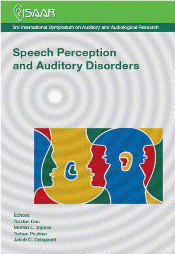Side-effects of binaural tone vocoding on recognising target speech presented against spatially separated speech maskers
Abstract
Previous experiments have indicated that monaural Temporal Fine Structure (mTFS) information aids Speech Reception. In these experiments mTFS was either kept or substituted using a tone-vocoder. Results showed that hearing-impaired subjects were not able to utilise mTFS information to the same degree as normal-hearing subjects. A first step towards a more ecological experiment would be to exploit the tone-vocoder paradigm in a simulated spatial setup, and measure binaural TFS (bTFS) benefit. However, by the introduction of a binaural tone-vocoder, a concern arose that artificial ITD cues pointing to a direction determined by the phase difference between the carriers of the two channels, would be introduced in addition to the intended removal of the original Interaural Time Difference (ITD) by vocoding. This experiment investigated this concern, by measuring speech reception for target speech presented against spatially separated speech maskers. 21 young normal hearing, 10 elderly normal hearing and 11 elderly hearing impaired subjects were tested in a fixed spatial condition with either the artificial ITD pointing forward (0o azimuth) or ±50o.
References
Andersen, M. R., Kristensen, M. S., Neher, T. and Lunner T. (2010). “Effect of Binaural Tone Vocoding on Recognising Target Speech Presented Against Spatially Separated Speech Maskers” Poster at IHCON 2010.
Behrens, T., Neher, T., and Johannesson, R.B. (2007). “ERH-42-08-05 Evaluation of a Danish speech corpus for assessment of spatial unmasking” Poster at ISAAR.
Hopkins, K., Moore, B. C. J., and Stone, M. A. (2008). “Effects of moderate cochlear hearing loss on the ability to benefit from temporal fine structure information in speech” J. Acoust. Soc. Am. 123 (2), 1140-1153.
ISO 7029:2000, “Acoustics – Statistical distribution of hearing thresholds as a function of age”.
Kuhn, G.F. (1977). “Model for the interaural time differences in the azimuthal plane.” J. Acoust. Soc. Am. 62 (1), 157-167.
Lunner, T., Hietkamp, R. K., Andersen, M. R., Hopkins, K., and Moore, B. C. J. (in press) “Effect of speech material on the benefit of temporal fine structure information in speech for normal-hearing and hearing-impaired subjects” Ear and Hearing.
Moore, B. C. J. and Glasberg, B. R. (1998). “Use of a loudness model for hearing aid fitting. I. Linear hearing aids” Br. J. Audioligy. 32, 317-335.
Additional Files
Published
How to Cite
Issue
Section
License
Authors who publish with this journal agree to the following terms:
a. Authors retain copyright* and grant the journal right of first publication with the work simultaneously licensed under a Creative Commons Attribution License that allows others to share the work with an acknowledgement of the work's authorship and initial publication in this journal.
b. Authors are able to enter into separate, additional contractual arrangements for the non-exclusive distribution of the journal's published version of the work (e.g., post it to an institutional repository or publish it in a book), with an acknowledgement of its initial publication in this journal.
c. Authors are permitted and encouraged to post their work online (e.g., in institutional repositories or on their website) prior to and during the submission process, as it can lead to productive exchanges, as well as earlier and greater citation of published work (See The Effect of Open Access).
*From the 2017 issue onward. The Danavox Jubilee Foundation owns the copyright of all articles published in the 1969-2015 issues. However, authors are still allowed to share the work with an acknowledgement of the work's authorship and initial publication in this journal.


